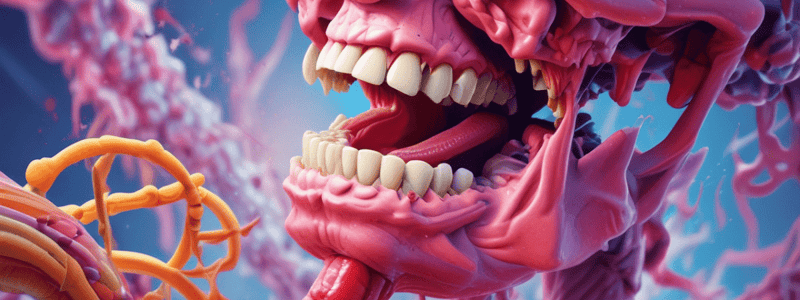Podcast
Questions and Answers
Which of the following is NOT a common risk factor for acquired hypercoagulable states?
Which of the following is NOT a common risk factor for acquired hypercoagulable states?
- Prolonged bed rest or immobilization
- Advancing age
- Genetic predisposition to thrombosis (correct)
- Cigarette smoking
Which of the following clinical conditions is NOT associated with an increased risk of cardiac thrombi formation?
Which of the following clinical conditions is NOT associated with an increased risk of cardiac thrombi formation?
- Myocardial infarction
- Rheumatic mitral stenosis
- Congestive heart failure
- Hypertrophic cardiomyopathy (correct)
What is the main pathogenetic mechanism for the formation of cardiac thrombi?
What is the main pathogenetic mechanism for the formation of cardiac thrombi?
- Decreased synthesis of coagulation factors
- Increased production of antithrombin III
- Increased platelet aggregation
- Endothelial cell injury and abnormal blood flow (correct)
Which of the following is a common location for arterial thrombi?
Which of the following is a common location for arterial thrombi?
Which of the following is a predisposing clinical condition for the development of hypercoagulable states?
Which of the following is a predisposing clinical condition for the development of hypercoagulable states?
How can oral contraceptives or the hyperestrogenic state of pregnancy contribute to hypercoagulability?
How can oral contraceptives or the hyperestrogenic state of pregnancy contribute to hypercoagulability?
What is the primary function of the endothelial layer in relation to thrombosis?
What is the primary function of the endothelial layer in relation to thrombosis?
Which of the following conditions is primarily associated with venous thrombosis due to stasis?
Which of the following conditions is primarily associated with venous thrombosis due to stasis?
Which of the following conditions is associated with hypercoagulability and an increased risk of thrombosis?
Which of the following conditions is associated with hypercoagulability and an increased risk of thrombosis?
Which of the following is a heritable hypercoagulable state associated with an increased risk of thrombosis?
Which of the following is a heritable hypercoagulable state associated with an increased risk of thrombosis?
Which of the following is an acquired hypercoagulable state that can increase the risk of thrombosis?
Which of the following is an acquired hypercoagulable state that can increase the risk of thrombosis?
Which of the following mechanisms is primarily responsible for thrombosis in arterial circulation and cardiac chambers?
Which of the following mechanisms is primarily responsible for thrombosis in arterial circulation and cardiac chambers?
What are the primary abnormalities that lead to thrombosis according to the text?
What are the primary abnormalities that lead to thrombosis according to the text?
Which factor determines whether thrombus formation, propagation, or dissolution occurs?
Which factor determines whether thrombus formation, propagation, or dissolution occurs?
What role does endothelial injury play in thrombosis?
What role does endothelial injury play in thrombosis?
What is the Virchow triad according to the text?
What is the Virchow triad according to the text?
Which of the following can cause endothelial injury leading to thrombosis?
Which of the following can cause endothelial injury leading to thrombosis?
What is the significance of alterations in normal blood flow in thrombus formation?
What is the significance of alterations in normal blood flow in thrombus formation?
Flashcards are hidden until you start studying


